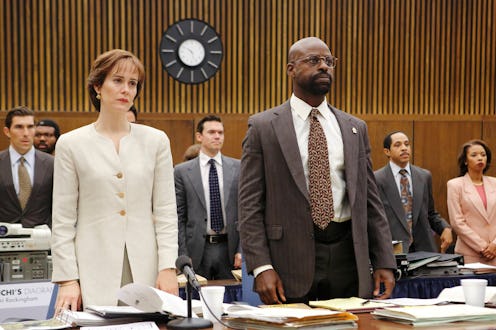
While the focal point of American Crime Story so far has been O.J. Simpson and the lawyers working to either defend or prosecute him, there's an incredibly important factor to all of this that has been glossed over so far — the jury in the O.J. Simpson trial. Seen earlier in the season as bargaining chips for the two sides as they tried to stack the odds in their favor, the jury will take the spotlight in Episode 8, "A Jury In Jail." The episode focuses on how the jury's will and enthusiasm drains after being sequestered for what was only supposed to be a three-month trial. Before they get their time as the focus of American Crime Story, you may want to get to know the real jury from the Simpson trial.
FX has spared no expense in portraying the trial as accurately a possible. While the jury itself is full of a diverse cast of characters that could warrant their own television series, it seems that great attention has been paid to accurately portraying each of the individual jurors. Comparing the actors cast to real court drawings and news reports makes it appear that American Crime Story provides an insightful look into the struggles of the real jury.
As reported by the New York Times, the jury initially consisted of 12 jurors and 12 alternates. However as the trial went on, more and more jurors were dismissed for a variety of reasons. In 1996, USA Today profiled the jurors, and they seem accurately reflected on the series. The report also details jurors who were dismissed, including a "52-year-old married man, half American Indian and half white ... Sources say he was suspected of writing a book about the trial," and a "48-year-old single black man, who does quality control for Hertz Corp., for whom Simpson was a spokesman." While some liberties may have been taken to present these situations on American Crime Story, such as a picture of the Hertz employee and Simpson shaking hands being used to justify the juror's dismissal on the series, the broad strokes in each of these real personalities is there on screen, and more so for certain members of the final jury.
In the show, Shapiro and the Dream Team take to nicknaming members of the jury, including one woman they call "The Devil," whose depiction does match a juror described by USA Today as a "60-year-old divorced white woman ... she was the lone holdout in another murder case and managed to get other jurors to change their minds." There's also "Poker Face," the name attributed to the jury's Foreman, Armanda Cooley, who would go on to co-author the book Madame Foreman: A Rush to Judgement? with two other jurors about their experience. However, whether these nicknames were actually used by the defense or just a dramatic flourish for American Crime Story is not clear.
As reported by the NY Daily News, the Simpson jury was sequestered for 265 days, the longest jury in American history. While in the series the jury is portrayed as initally being ready for a vacation, the realities of the sequester are soon revealed. As Keene Trial Consulting explains, "It’s no party for the sequestered juror. No morning paper. No TV. No internet cable or WiFi access in your room. No phone. They even take the Bible from your bedside table." We'll see how this effects the jury in different ways on next week's episode of American Crime Story.
The jury is the most important part of any trial, as they are the ones who make the final decision. The lawyers spend hours determining how to appeal not to the judge or the public, but to a jury of peers who decide the fate of the case. The eventual ruling of Simpson lives on as one of the most talked about declarations of "not guilty" in history, but the best way to understand how the jury to came to that conclusion is to understand the jury themselves, which is exactly what American Crime Story strives to do.
Image: Ray Mickshaw/FX